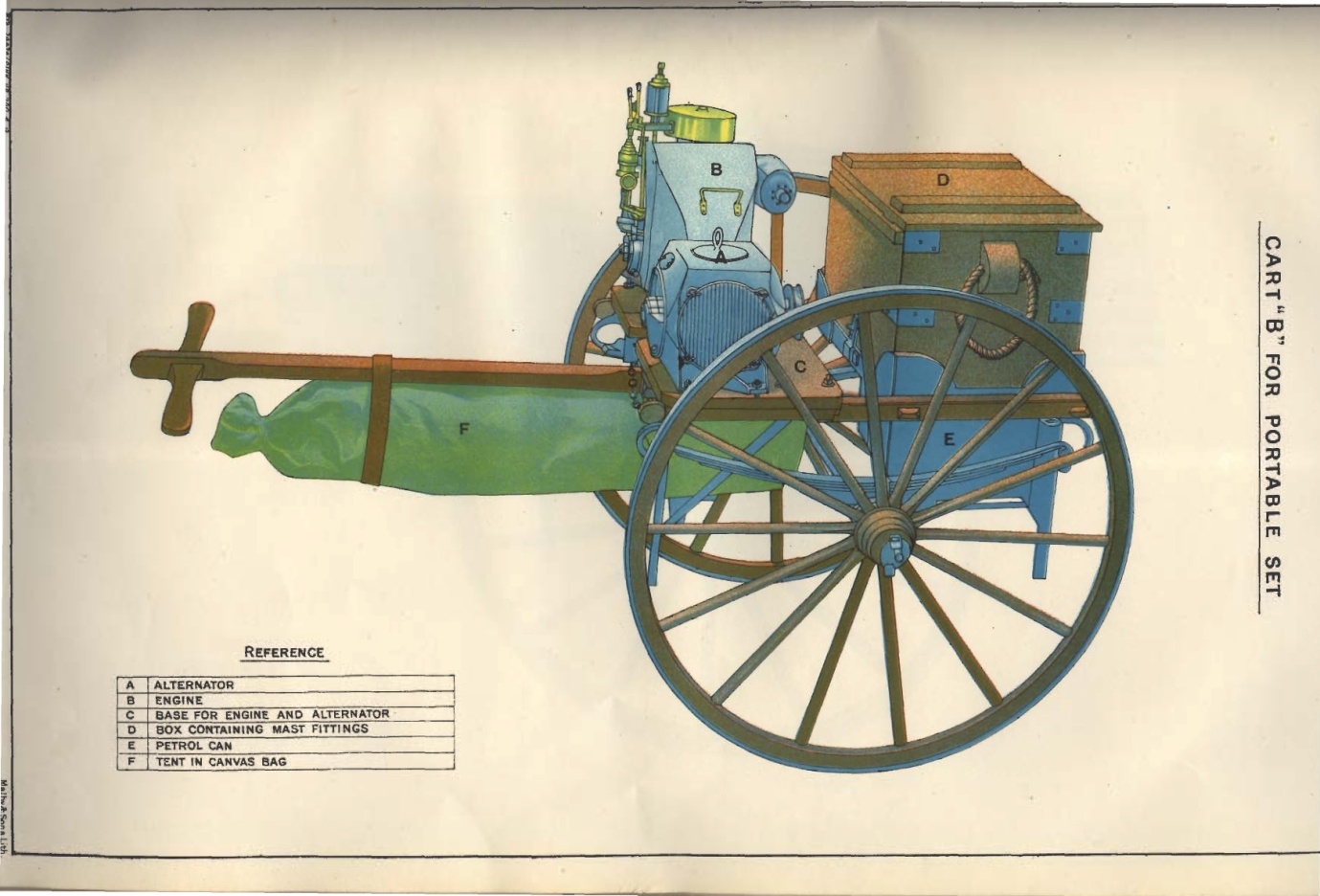
The Wireless War on Land
At the start of the war the possibilities for wireless telegraphy on the battlefield were hardly recognised by the British Army. Within the army no separate wireless dedicated organisation existed, men from various units were simply detailed to 'attend to' such wireless equipment as existed in addition to their normal duties.
Throughout most of the Great War despite huge strides in technology and equipment the primary means of army battle field communications were still visual, wire telegraph and despatch. Most despatches were either by runner or horseback. But traditional visual signalling techniques soon proved unsuitable for trench warfare as the operator had to show himself to enemy snipers, but the heliograph, flags and lamp still had an important communications role, particularly where the army was moving too quickly to establish a telephone cable network.
In 1915 signalling discs and shutters were introduced which could be operated from cover and read using a periscope. The Telegraph Troop was formed as a mounted unit and horses were used as draft animals until 1937. Dogs were trained to carry messages between trenches and horses, mules and dogs were all used during the war to lay cables. Pigeons have been used to carry messages since the Greeks. The British Army used pigeons to bring back messages from the front line for the entire war. At various periods during the war there were over 20,000 pigeons and 370 'pigeoneers' in the war zone. Very often pigeons were the sole means of communication for the British Army.
In 1912 the Royal Engineer Signal Service had been formed and made responsible for the visual, telegraph, telephone, signal despatch and later wireless communications from HQ down to Brigades and for artillery communications down to Batteries. But at the start of the war senior officers looked upon wireless as possibly a useful adjunct to visual and line signalling, but its main sphere of use was at first confined to communication between fast moving mobile cavalry and their H.Q.
It was the stalemate of trench warfare that started to drive the technology of wireless communication forward, but at the outbreak of WWI the army only had a small number of wireless sets. These were mainly spark transmitters which operated on long wave and were cumbersome, heavy and unreliable. On the day the British Expeditionary Force landed in France, its total self-propelled mobile wireless force consisted of a single lorry fitted with one Marconi wireless transmitter and receiver. By the time of the first Battle of the Marne in September 1914, the force had expanded to just ten units.

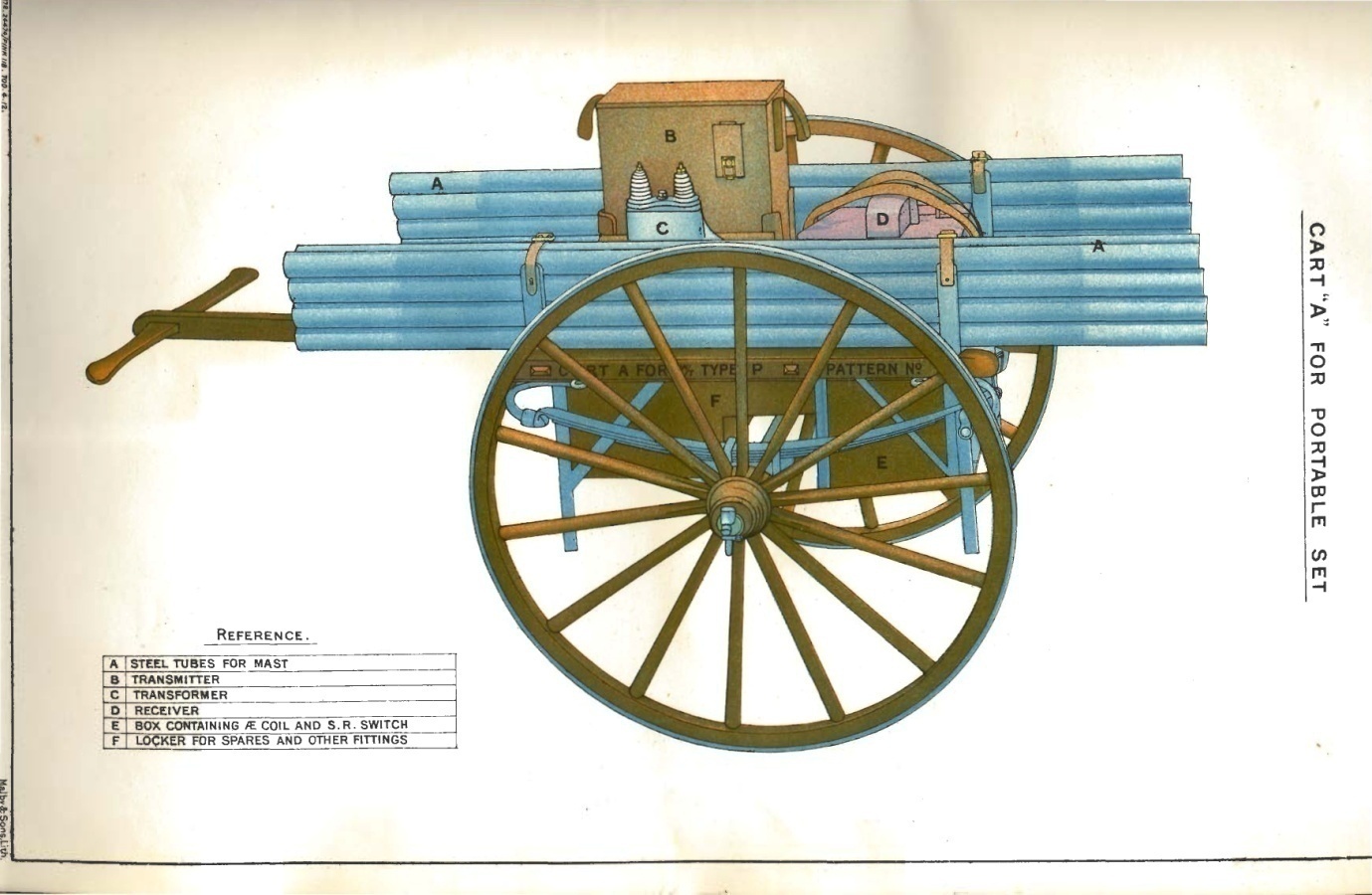
British Army Portable Wireless Set c. 1911 (MWT)
By 1911 the Marconi Company had already provided the army with a battlefield wireless station by designing two small ‘Portable Sets’.
They were called the 'Infantry type' and the 'Cavalry type' sets, and differed from one another only in the details of transport arrangements. The power of the sets was about 4 kW with a range guaranteed 'over ordinary country' around 40 to 50 kilometres. Three wave-lengths are used, 500, 600 and 700 metres but tuning was described as being 'rather approximate'. The transmitting gear used an ordinary petrol engine that drove an alternator direct through a flexible coupling.
The Receiving Gear was the then usual commercial Marconi receiving circuit but offered a Fleming oscillation valve detector. It was stated that designs were complete with a change-over switch-board so that a crystal detector, consisting of a brass plate in contact with a crystal of carborundum could be used as an alternative to the valve.
As the first months of War passed the British Army, like the Navy, would soon place considerable demands upon the Marconi Company in an effort to catch up. In August 1914, the Chief of the Marconi Training School at Broomfield, near Chelmsford, was seconded to the War Office and charged with the organisation of a large-scale training school at the Crystal Palace for the instruction of officers and engineers of the allied forces in the use of wireless in the field. At the same time a Field Station development section at the Marconi New Street Works was reformed as a separate department in order to meet the ever increasing needs of the armies overseas.
By the second year of the war wireless telegraphy in some form was in use by the practically all the world's military and naval forces. But signals officers and commanders in the field and at headquarters still rarely took into account the possibility of interception or deception. Unfortunately, the lack of really secure ciphers still made wireless transmission risky, careless or rushed operators made it dangerous. If intercepting wire cable telegraph traffic was simple, then with wireless it was almost unavoidable.
Messages were broadcast over the airwaves, and anybody could pick them up. Despite the lack of security, there was still often no alternative to wireless, since it allowed governments to communicate with warships at sea and armies on the move. By October 1915 the war of movement had ended. The advent of trench warfare brought to an end the limited role which wireless telegraphy had so far played.
Instead an urgent new requirement arose. The main Corps H.Q needed to be fully informed, on a continuous basis, about the situation on the front line. This was speedily organised by adopting a relay system consisting of a power Morse code buzzer in the front line feeding to a 50 watt mobile spark transmitting set which in turn was in contact with a 120 watt spark set further back towards base. The ultimate link was a 1.5 kW light motor set which was well within range of H.Q. Much of the output of the Marconi New Street works in Chelmsford was at this time devoted to the provision of such sets.

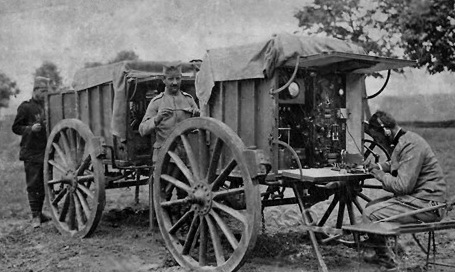
Marconi 1.5 kW Field Set (MWT)
The wagon had two compartments, one for the Wireless equipment and one for the accumulators. These accumulators were either swapped out on location and taken away to be charged at a common central charging station or a mobile Charger came around once a day to each location. During WW1 the British supplied Serbia (then an ally of the UK and France) with the same Marconi Mounted Wireless wagons.

Marconi 1.5 kW Field Set (MWT)
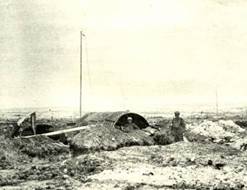 Forward Wireless Station,
The Somme, 1916.
Forward Wireless Station,
The Somme, 1916.
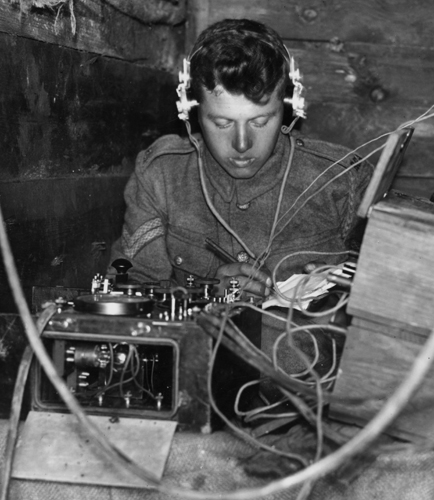
Interior of Royal Engineers, British Army forward wireless station,
Moyenneville, the Somme, c. 1917. (MWT)
On 2nd January 1915, the importance of wireless in the British Army was recognised by the establishment of a Wireless Signal Company as a unit in its own right. One of the new company's prime tasks other than relaying orders and intelligence was to provide the ground links to circling Royal Flying Corps aircraft to provide intelligence on the fall of artillery shells.
The aircrew that were engaged in artillery spotting obviously flew in the face of great danger, but the wireless operators on the ground had problems of a similar magnitude. Depending on the strength of a squadron, they were detached to siege batteries of the Royal Artillery and so were exposed to even greater dangers than other members of the ground crew. Their living quarters were invariably bad and with each man being responsible for the maintenance and operation of his equipment they always had a corresponding high workload.
The basic trench equipment comprised a 'Wireless Set Receiving Mark 3', which was essentially a powerful crystal set, and a thirty foot mast which broke down into eight sections. This was used to support the aerial, which had to be at right angles to the battle 'Front' and sloped down to an eight foot pole near to the wireless operators position. The operator was in telephone contact with various batteries and could be responsible for a large portion of the Front line.
While at equal risk from the dangers of trench warfare at the Front including snipers and gas attacks German aircraft were also engaged on artillery spotting duties, and the sighting of a British aerial mast would indicate to them the presence of a high value target.
A wireless ground station would very likely come under sustained artillery attack, and the operator had two alternatives; direct his aircraft to find the battery which was shelling him, and engage it with counter-battery fire, or to pack up and move his post to a new site. This would entail the laying of new telephone cables to the batteries under his control and so the post would be effectively neutralised for a period even if the equipment and the operator was not destroyed.
A newspaper reported in 1915 that:
'The wireless equipment with which General Joffé keeps in touch with the fighting line of the allies has a range of 200 miles, and is portable.
Within 15 minutes after the command is given, the station can be erected and put in operation. At the front, smaller and lighter equipments, known as 'knapsack' stations, are employed. These are so constructed that one complete set can be divided up and carried by four men, with an average weight to each man of 20 lb. Five minutes after the command for erection is given, these sets are in operation.
Besides the knapsack stations, a new and ingenious auxiliary equipment has been devised for cavalry scouting duty, called 'whisker wireless.' This odd name arises from the bristling appearance of the antennae which project like the quills of a porcupine from the horses' flanks.
Landing stations, having a range of 50 miles and designed for impromptu service, are used by the marines. For example, when a cruiser anchors off shore and sends a detachment of men for scouting duty, they carry with them this very compact equipment which can be set up hurriedly.
Probably the
most novel use to which wireless has been put in this war is in
aeroplane service. The equipment installed on the French and Belgian
fliers weighs about 100 lb., and is exceedingly compact and simple.
The metal frame of the aeroplane forms the antennae, while a long
trailing wire is used for 'ground.' This wire is attached so that
should it become entangled in a tree or other obstruction, it
automatically pulls loose, and another one is substituted.
Wireless communication over a distance of 54 miles has been carried on from an aeroplane to a land station in the U. S. Army, but greater ranges than five to ten miles are not practical or necessary. In service, the wireless-equipped aeroplane is sent on scouting duty over the enemy's lines from a base at which a knapsack station is located. It is rarely necessary for the aeroplane to fly to a greater distance than two or three miles from this base. As he flies over the enemy, the operator telegraphs the condition or manoeuvres of the enemy to the knapsack station. Surprises on both sides are constantly being frustrated in this manner. As a matter of incidental interest, it is due principally to this fact that there have been no recorded surprise attacks made by either side on the Franco-German frontier and that a deadlock exists now.'
In
1916 on the Somme the Battalion commander, 7th battalion of the
Yorkshire Regiment (The Green Howards) Ronald d’Arcy Fife could
only command and control the part of the battlefield over which his
voice could be heard or over which runners could carry and return
messages. Visible communications whilst having the virtue of being
seen over greater distances and improving the speed of communications
had the draw-back of being seen to foe as well as friend and targeted
for destruction. Such rudimentary communications led to tragic
mistakes and lost the allies tactical and strategic opportunities.
By 1917 men like Fife had fed their experience into the system and, despite an enduring image, British strategic command were receptive to new ideas, embraced technology and established the administrative and logistical means of sharing experience-based best practice.
In the May, 1917 Popular Science Monthly, Capt. A. P. Corcoran's Wireless in the Trenches reviewed radiotelegraph operations at the British front lines, where operators with portable transmitters proved invaluable, for 'If a gas attack is coming, it is he who sends the warning to the men behind to put their gas helmets on.'
Michael Stephen LoCicero wrote 'A Moonlight Massacre, The Night Operation on the Passchendaele Ridge, 2nd December 1917' and captured the almost chaotic mix of old and new technologies deployed on the battlefield:
'In 1917 wireless technology was still in its infancy; so telephones, telegraph, signal lamps, semaphore, carrier pigeons and runners were all utilised in order to provide multiple communication avenues.
A network of seventeen visual signalling stations, for use by infantry battalions, machine-gun companies and artillery, was to be extended from the frontline to Canal Bank. Company runners were to deliver messages to battalion HQs. Runners dispatched from battalions and the brigade forward signal station would carry messages to the rear by a series of relay posts set up near established linemen posts at 'intervals of 400 yards along duckboard tracks....
Mounted orderlies, the last link in the chain, would then carry messages from artillery groups to Division HQ. Responsibility for the organisation of visual signals and runners devolved on signal officers attached to assault battalions, forward brigade, support brigade and artillery groups.
Assault battalions were issued eight pigeons which, on release, would fly directly to a pigeon loft at Vlamertinghe. Artillery Forward Observation Officers (FOOs) were expected to 'draw on the nearest battalion for any birds they require'. In addition, Brigade HQs were issued 16 pigeons that would home-in to a loft at Watou. This means of communication, it was pointed out, 'is not as reliable as usual owing to the time of year. Any messages of great importance
Use was likely made of the 50-Watt Spark transmitter at division and brigade HQs, and the newly adopted W/T Forward 20-Watt Spark Transmitter. The latter had a range of 2,000 to 3,000 yards. Major E.E. Evelegh (CO 32nd Division Signal School) subsequently remarked that 'Spark wireless was found very reliable on this occasion and good use was made of it.'
Any W/T station could communicate with any other. Set 1 was for communications with MG companies on the Bellevue Spur, artillery observations posts, and 25 Brigade. Set 2 was located at 97 Brigade HQ (Kronprinz Farm). Set 3 at 14 Brigade HQ (Kansas). Set 4 at Cheddar Villa for communication with artillery groups. Set 5 (II Corps Directing Station) would be in 'close touch' with 32nd Division HQ and II Corps Heavy Artillery.
Divisional communications infrastructures were often hampered by institutionalised constraints. John Ferris noted 'that signals security fed from communications systems, and like all parasites, sapped the strength of its host. The purpose of these systems was to maintain command and control.' Their success shaped operations. The proliferation of listening sets utilised by both sides to monitor enemy phone traffic up to 3,000 yards from the forward line, brought about the establishment of measures whereby one's own telephone traffic also had to be monitored. Armies sought to minimise this security threat by limiting telephone usage. They often stripped telephones from their battalions, precisely where these were most needed, while the reluctance of personnel to face the lengthy process of enciphering messages hampered the adoption of radio until the armistice.
As a senior British wireless officer noted in 1917:
'Ciphers have always been the bugbear of wireless. People don't like, or they have not the time, to do the enciphering [sic]. The result is that messages are sent by some other means than that which requires ciphers or code, such as runner'. By 1918, wireless provided the solution to the signals problem in the field, 'but the stranglehold of signals security throttled its use'.
Three wireless stations were to be established along the cable route Wieltje – Bellevue, while a VIII Corps continuous wave [CW] wireless set was to be setup in the forward area. Nine visual signal stations were to be established at Gallipoli Dugouts, Bellevue, Meetcheele, Mosselmarkt, and with the five companies holding the frontline. Runner relay posts were also to be established along routes extending from company HQs to Meetcheele, Bellevue and Korek
The VIII Corps forward zone wireless station was also to be placed in direct touch with a station situated near the divisional artillery HQs.
Five visual signalling stations (established at Korek, Bellevue, Passchendaele, Meetcheele and Mosselmarkt) were assigned to support the artillery. Lateral cables were also to be extended – from a cable junction situated between Canal Bank and the exchange at Gallipoli Dugouts - north and south to supporting batteries. By the close of November, 8t Division's communications infrastructure had been successfully extended west to east for approximately 11,000 yards from Canal Bank to the apex of the Passchendaele Salient.
Spark wireless sets were to be employed during the attack. Power Buzzer, amplifier and CW sets would not be utilised. Five wireless stations (established at Bellevue, Kronprinz Farm, Kansas Cross, Cheddar Villa, and II Corps Directing Station) were in place before the assault.
All messages, except in cases of emergency, had to be sent in code: 'If handed in 'in clear' they will be enciphered and deciphered by the wireless operators unless franked 'in clear' by an officer. In all cases messages must be brief'.
Wireless stations would, in order to communicate with supporting artillery groups, make direct contact with RFC receiving sets only during hours of darkness (4:30 to 6:30 pm). Special attention was to be paid to this means of communication 'especially in the case of SOS messages and cancel SOS messages'.
Once the battle had commenced there was little enough the individual general could do to influence its course and conduct. The friction of war and the fragility of most available means of communication made the overall situation complex and difficult and it was only by inculcating these standard procedures and battle drills that the British generals could commit their troops to battle with confidence.
Application of some sort of simple substitution code prevented awareness of intent and unit identifications from being obtained by German 'Moritz II' telephone listening sets and wireless intercept stations.
Meanwhile, wireless intercept stations dispatched their findings with surprising alacrity to Corps 'I' sections, which, in turn, passed on the information to VIII and II corps HQ. Some idea of the German predicament was thus discerned, although the immediate value of such intelligence was, to a certain extent, limited.

1917 W/T Trench Set Transmitter
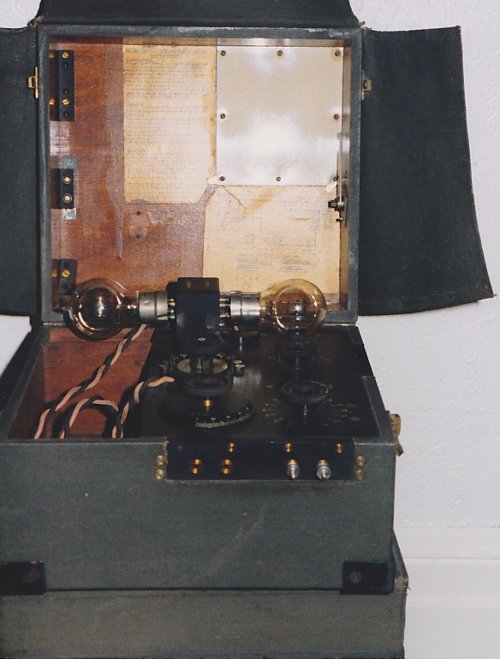
1917 W/T Trench Set Receiver
By 1917 valves had been fitted to the portable ‘Continuous Wave Transmitters and Receivers’ used in the 'Forward Area' trenches. The new Trench Sets had a range of about two miles but still required a 'Volunteer' to go 'over the top' and put up a 100 foot long aerial.
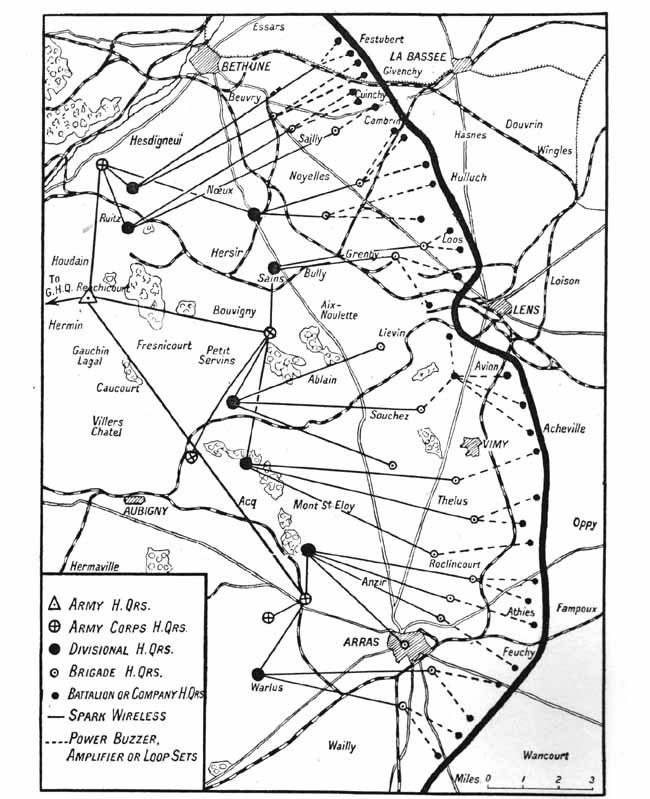
The First Army Front just prior to the Great Offensive in August 1918
showing Wireless telegraphy Positions.
It is highly probable that outside of wireless intercepts, artillery spotting and D/F use that the British Army did not fully utilise the full strengths of wireless communication. But the lessons learnt allowed tactics to be continually honed and improved thus foreshadowing the all-arms strategy (the co-ordination of infantry, artillery and air-power including the use of wireless) on which success in the 100 days from August to November 1918 was based.